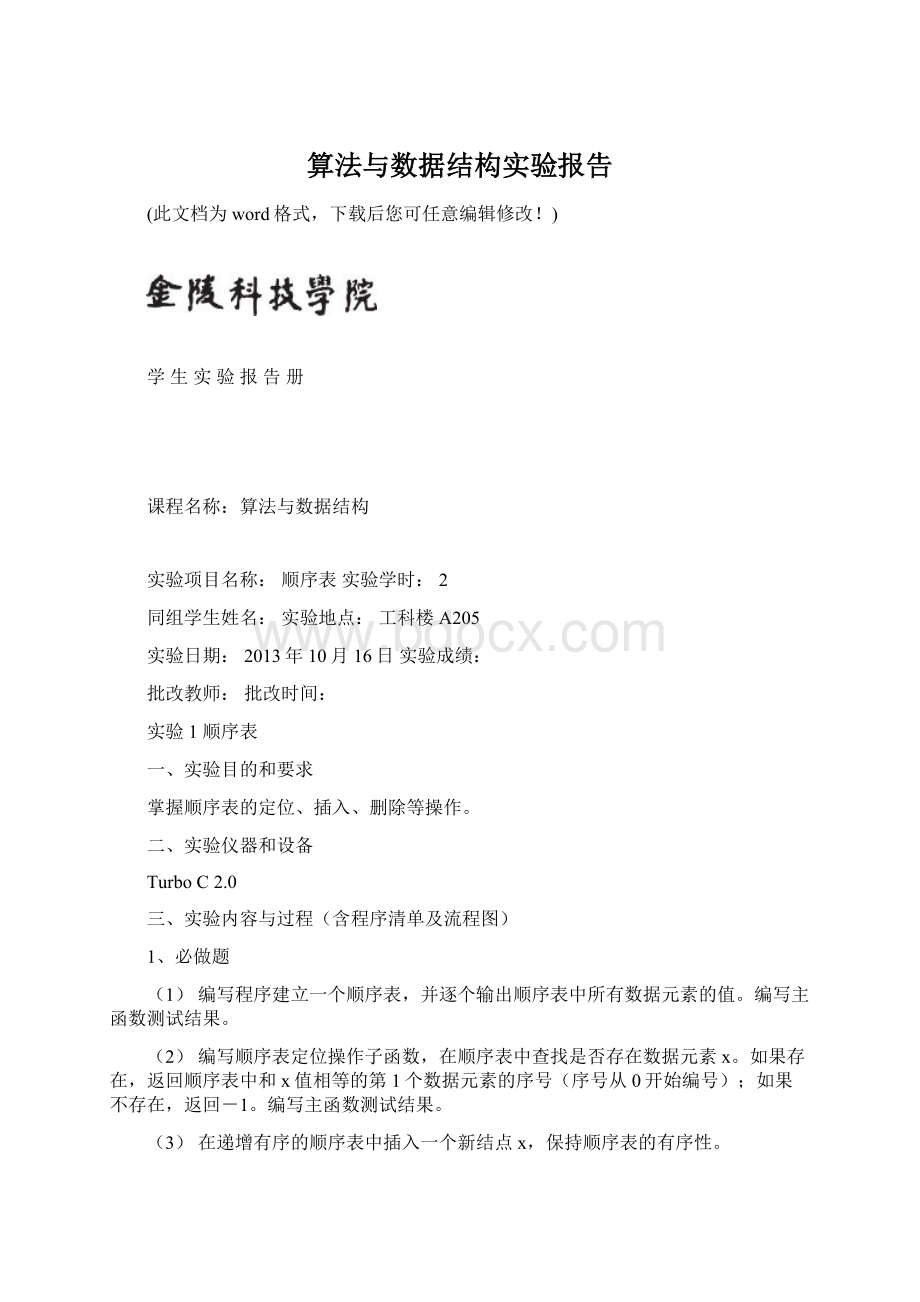算法与数据结构实验报告.docx
《算法与数据结构实验报告.docx》由会员分享,可在线阅读,更多相关《算法与数据结构实验报告.docx(37页珍藏版)》请在冰豆网上搜索。

算法与数据结构实验报告
(此文档为word格式,下载后您可任意编辑修改!
)
学生实验报告册
课程名称:
算法与数据结构
实验项目名称:
顺序表实验学时:
2
同组学生姓名:
实验地点:
工科楼A205
实验日期:
2013年10月16日实验成绩:
批改教师:
批改时间:
实验1顺序表
一、实验目的和要求
掌握顺序表的定位、插入、删除等操作。
二、实验仪器和设备
TurboC2.0
三、实验内容与过程(含程序清单及流程图)
1、必做题
(1)编写程序建立一个顺序表,并逐个输出顺序表中所有数据元素的值。
编写主函数测试结果。
(2)编写顺序表定位操作子函数,在顺序表中查找是否存在数据元素x。
如果存在,返回顺序表中和x值相等的第1个数据元素的序号(序号从0开始编号);如果不存在,返回-1。
编写主函数测试结果。
(3)在递增有序的顺序表中插入一个新结点x,保持顺序表的有序性。
解题思路:
首先查找插入的位置,再移位,最后进行插入操作;从第一个元素开始找到第一个大于该新结点值x的元素位置i即为插入位置;然后将从表尾开始依次将元素后移一个位置直至元素i;最后将新结点x插入到i位置。
(4)删除顺序表中所有等于X的数据元素。
2、选做题
(5)已知两个顺序表A和B按元素值递增有序排列,要求写一算法实现将A和B归并成一个按元素值递减有序排列的顺序表(允许表中含有值相同的元素)。
程序清单:
1、#definemaxsize100
typedefstruct{
intdata[maxsize];
intlast;
}sequenlist;
main()
{
inti;
sequenlistl={{4,3},7};
printf("\nThelistis:
");
for(i=0;i<=l.last;i++)printf("%2d",l.data[i]);
}
2、#definemaxsize100
typedefstruct{
intdata[maxsize];
intlast;
}sequenlist;
main()
{
intx,i,s=-1;
sequenlistl={{4,3},7};
printf("\nThelistis:
");
for(i=0;i<=l.last;i++)
printf("%2d",l.data[i]);
printf("\nPleaseinputthenumber:
");
scanf("%d",&x);
for(i=0;i<=l.last;i++)
if(l.data[i]==x)
{s=i;break;
}
printf("%d",s);
}
3、#definemaxsize100
typedefstruct{
intdata[maxsize];
intlast;
}sequenlist;
main()
{
inti,x,j;
sequenlistl={{},5};
printf("\nThelistis:
");
for(i=0;i<=l.last;i++)
printf("%2d",l.data[i]);
printf("\nInputtheinsertnumber:
");
scanf("%d",&x);
for(i=1;i<=l.last;i++)
if(l.data[i-1]>x)break;
for(j=l.last;j>=i-1;j--)
l.data[j+1]=l.data[j];
l.data[i-1]=x;
l.last++;
printf("thelistafterinsertionis:
\n");
for(j=0;j<=l.last;j++)
printf("%3d",l.data[j]);
}
4、#definemaxsize100
typedefstruct{
intdata[maxsize];
intlast;
}sequenlist;
main(){
inti,j,x=0,k=0;
sequenlistL={{},9};
printf("\nThelistis:
");
for(i=0;i<=L.last;i++)printf("%3d",L.data[i]);
printf("\nPleaseinputanumberx:
");
scanf("%d",&x);
for(i=1;i<=L.last+1;i++)
if(L.data[i-1]==x){
for(j=i;j<=L.last+1;j++)L.data[j-1]=L.data[j];
L.last--;
i--;
k=1;
}
if(k==1){
printf("Thelistafterdeletionis:
\n");
for(j=0;j<=L.last;j++)printf("%3d",L.data[j]);
}
elseprintf("Notfound!
\n");
}
四、实验结果与分析(程序运行结果及其分析)
1、输出结果:
Thelistis:
25682843
2、输出结果:
Thelistis:
25679843
Pleaseinputthenumber:
8
5
Thelistis:
25679843
Pleaseinputthenumber:
1
-1
3、输出结果:
Thelistis:
135679
Inputtheinsertnumber:
8
Thelistafterinsertionis:
1356789
4、输出结果:
Thelistis:
1357246829
Pleaseinputanumberx:
5
Thelistafterdeletionis:
137246829
Thelistis:
1357246829
Pleaseinputanumberx:
11
Notfound!
五、实验体会(遇到问题及解决办法,编程后的心得体会)
遇到问题:
读取数据元素时,误将==写成=,导致错误。
实验过程中,顺序表的赋值没有弄懂,以致输出多个0或者少输出。
格式运算符也要正确控制,否则系统会停止工作。
实验体会:
通过实验掌握了顺序表的基本操作,如初始化、插入、读取元素、删除等等。
并了解到线性表顺序存储结构的特点,即逻辑关系上相邻的两个元素在物理位置上也相邻,然而从另一方面来看,在做插入和删除时需要移动大量元素。
本次实验基本完成了实验要求的目的,顺序表的初始化,定义,插入,查找等,更好的了解了顺序表基本操作的算法,以及更直观的了解了数据结构在C语言环境下的体现。
实验项目名称:
单链表实验学时:
2
同组学生姓名:
实验地点:
工科楼A205
实验日期:
2013年10月23日实验成绩:
批改教师:
批改时间:
实验2单链表
一、实验目的和要求
1、实验目的
掌握单链表的定位、插入、删除等操作。
2、实验要求
(1)注意链表的空间是动态分配的,某结点不用之后要及时进行物理删除,以便释放其内存空间。
(2)链表不能实现直接定位,一定注意指针的保存,防止丢失。
二、实验仪器和设备
TurboC2.0
三、实验内容与过程(含程序清单及流程图)
1、必做题
(1)编写程序建立一个单链表,并逐个输出单链表中所有数据元素。
(2)在递增有序的单链表中插入一个新结点x,保持单链表的有序性。
解题思路:
首先查找插入的位置然后进行插入操作;从第一个结点开始找到第一个大于该新结点值的结点即为插入位置;然后在找到的此结点之前插入新结点;注意保留插入位置之前结点的指针才能完成插入操作。
(3)编写实现带头结点单链表就地逆置的子函数,并编写主函数测试结果。
2、选做题
已知指针LA和LB分别指向两个无头结点单链表的首元结点。
要求编一算法实现,从表LA中删除自第i个元素起共len个元素后,将它们插入到表LB中第j个元素之前。
程序清单:
1、#include
typedefintdatattype;
typedefstructnode{
chardata;
structnode*next;
}linklist;
main(){
charch;linklist*head,*s,*r,*p;
head=malloc(sizeof(linklist));
r=head;
scanf("%c",&ch);
while(ch!
='$'){
s=malloc(sizeof(linklist));
s->data=ch;
r->next=s;
r=s;
scanf("%c",&ch);
}
r->next=NULL;
r=head->next;
while(r!
=NULL){
printf("%c",r->data);
r=r->next;
}
}
2、#include"stdio.h"
#include"stdlib.h"
typedefstructnode{
intdata;
structnode*next;
}linklist;
main(){
intx,y;
linklist*head,*s,*r,*p,*q,*m,*n;
clrscr();
head=malloc(sizeof(linklist));
r=head;
printf("inputtheordernumbers:
");
scanf("%d",&x);
while(x!
=0){
s=malloc(sizeof(linklist));
s->data=x;
r->next=s;
r=s;
scanf("%d",&x);
}
r->next=NULL;
printf("Pleaseinputtheinsertvalue:
");
scanf("%d",&y);
p=head->next;
while(p!
=NULL){
if(p->datanext;
elsebreak;
}
q=malloc(sizeof(linklist));
q->data=y;
m=head;
while(m->next!
=p)m=m->next;
q->next=p;
m->next=q;
n=head->next;
printf("thelistare:
");
while(n!
=NULL){
printf("%3d",n->data);
n=n->next;
}
}
3、#include"stdio.h"
#include"stdlib.h"
typedefstructnode{
intdata;
structnode*next;
}linklist;
main(){
inta;
linklist*head,*s,*r,*p,*q,*t;
clrscr();
head=malloc(sizeof(linklist));
r=head;
printf("Inputsomenumbers:
");
scanf("%d",&a);
while(a!
=0){
s=malloc(sizeof(linklist));
s->data=a;
r->next=s;
r=s;
scanf("%d",&a);
}
r->next=NULL;
printf("\nThelinklistbeforechangedis:
\n");
p=head->next;
while(p){
printf("%d",p->data);
p=p->next;
}
p=head->next;
q=p->next;
while(q!
=NULL){
t=q->next;
q->next=p;
p=q;
q=t;
}
head->next->next=NULL;
head->next=p;
printf("\nAfterchanged:
\n");
p=head->next;
while(p!
=NULL){
printf("%d",p->data);
p=p->next;
}
}
四、实验结果与分析(程序运行结果及其分析)
1、输入:
123abc$
输出结果:
123abc
2、输入:
inputtheordernumbers:
1357890
Pleaseinputtheinsertvalue:
:
4
输出结果:
thelistare:
1345789
3、输入:
Inputsomenumbers:
134580
输出结果:
Thelinklistbeforechangedis:
13458
Afterchanged:
85431
五、实验体会(遇到问题及解决办法,编程后的心得体会)
遇到问题:
编写成功后运行时,没有加入$导致程序运行不成功,不能够退出。
后注意到这个问题才继续运行下去。
实验体会:
在编写程序时,设置了结束字符一定要牢牢记住,并且在输入时观察仔细类型是什么,以及是否是输入一串有顺序的数字,编写成功不难,但是要规范格式,不能仅仅以完成程序为目的。
而完成这一章的实验也让我了解了,顺序表便于查找不便于插入删除,而链表恰恰相反,链表的插入删除只需要移动指针,而顺序表要从后往前依次移动,二者各有优劣。
实验项目名称:
堆栈和队列实验学时:
2
同组学生姓名:
实验地点:
工科楼A205
实验日期:
2013年10月30日实验成绩:
批改教师:
批改时间:
实验3堆栈和队列
一、实验目的和要求
(1)掌握应用栈解决问题的方法。
(2)掌握利用栈进行表达式求和的算法。
(3)掌握队列的存储结构及基本操作实现,并能在相应的应用问题中正确选用它们。
二、实验仪器和设备
TurboC2.0
三、实验内容与过程(含程序清单及流程图)
1、必做题
(1)判断一个算术表达式中开括号和闭括号是否配对。
(2)测试“汉诺塔”问题。
(3)假设称正读和反读都相同的字符序列为”回文”,试写一个算法判别读入的一个以’@’为结束符的字符序列是否是“回文”。
2、选做题
在顺序存储结构上实现输出受限的双端循环队列的入列和出列算法。
设每个元素表示一个待处理的作业,元素值表示作业的预计时间。
入队列采取简化的短作业优先原则,若一个新提交的作业的预计执行时间小于队头和队尾作业的平均时间,则插入在队头,否则插入在队尾。
程序清单:
1、typedefintdatatype;
#defineM100
typedefstruct{
chardata[M];
inttop;
}seqstack;
main(){
charstr[M];
intresult=0,i=0;
seqstacks;
s.top=0;
gets(str);
while(str[i]!
='\0'){
if(str[i]=='('){
s.top++;
s.data[s.top]='(';
}
if(str[i]==')'){
if(s.top==0){
result=1;
break;
}
elses.top--;
}
i++;
}
if(result==0&&s.top==0)printf("Match!
\n");
elseif(result==1)printf("Missingleft!
\n");
elseif(s.top>0)printf("Missingright!
\n");
}
2、#include
voidhanoi(intn,chara,charb,charc){
if(n==1)
printf("\nMovedisk%dfrompile%ctopile%c",n,a,c);
else{
hanoi(n-1,a,c,b);
printf("\nMovedisk%dfrompile%ctopile%c",n,a,c);
hanoi(n-1,b,a,c);
}
}
voidmain(){
intn;
clrscr();
printf("\nPleaseenterthenumberofdiskstobemoved:
");
scanf("%d",&n);
hanoi(n,'A','B','C');
}
3、#include
#defineM100
typedefstruct{
chardata[M];
inttop;
}seqstack;
main(){
charstr[M];
inti=0,n;
seqstacks;
s.top=0;
gets(str);
while(str[i]!
='@')i++;
if(i==1){
printf("Yes\n");
return;
}
n=i;
for(i=0;is.top++;
s.data[s.top]=str[i];
}
i=i-1;
if(n%2==0)
i++;
else
i=i+2;
while(ii++;
s.top--;
}
if(i==n)printf("Yes\n");
elseprintf("No\n");
}
四、实验结果与分析(程序运行结果及其分析)
1、输入:
(a)
输出结果:
Match!
输入:
(a
输出结果:
Missingright!
输入:
a)
输出结果:
Missingleft!
2、输入:
3
输出结果:
Movedisk1frompileAtopileC
Movedisk2frompileAtopileB
Movedisk1frompileCtopileB
Movedisk3frompileAtopileC
Movedisk1frompileBtopileA
Movedisk2frompileBtopileC
Movedisk1frompileAtopileC
3、输入:
qwewq@
输出结果:
Yes
输入:
qwerewr@
输出结果No
五、实验体会(遇到问题及解决办法,编程后的心得体会)
遇到问题:
在本章栈和队列中编程,有许多的if语句,编写时一不小心就会少加一个花括号,以致编写不成功。
在本章汉诺塔问题中,使用了栈以及函数的递归,这其中的过程一直不是很了解,在经过老师的讲解后,理解了大致过程。
实验体会:
递归函数是编程中经常会用到的一种函数,它可以实现许多我们在平时言语和解释上解决不了的问题,我们需要理解并且可以熟练的使用它,这对我们之后的编程会有很大的帮助。
而汉诺塔利用栈是一种很经典的递归的算法,这让我们理解栈和递归。
实验项目名称:
串实验学时:
2
同组学生姓名:
实验地点:
工科楼A205
实验日期:
2013年11月6日实验成绩:
批改教师:
批改时间:
实验4串
一、实验目的和要求
掌握串的存储及应用。
二、实验仪器和设备
TurboC2.0
三、实验内容与过程(含程序清单及流程图)
1、必做题
(1)编写输出字符串s中值等于字符ch的第一个字符的函数,并用主函数测试结果。
(2)编写输出字符串s中值等于字符ch的所有字符的函数,并用主函数测试结果。
解题思路:
可以将第一题程序改进成一个子函数,在本题中循环调用。
(3)设字符串采用单字符的链式存储结构,编程删除串s从位置i开始长度为k的子串。
2、选做题
假设以链结构表示串,编写算法实现将串S插入到串T中某个字符之后,若串T中不存在这个字符,则将串S联接在串T的末尾。
提示:
为提高程序的通用性,插入位置字符应设计为从键盘输入。
程序清单:
1、#definemaxsize100
typedefstruct{
charch[maxsize];
intcurlen;
}seqstring;
main(){
inti;
charch;
seqstrings={{"asdfghg"},6};
for(i=0;iprintf("%c",s.ch[i]);
printf("\nPleaseinputaacharacterch:
");
scanf("%c",&ch);
for(i=0;iif(s.ch[i]==ch){
printf("ch=s.ch[%d]=%c\n",i,s.ch[i]);
break;
}
if(i>=s.curlen)
printf("Notfind!
\n");
}
2、#definemaxsize100
typedefstruct{
charch[maxsize];
intcurlen;
}seqstring;
main(){
inti,flag=0;
charch;
seqstrings={{"abadeag"},6};
for(i=0;iprintf("%c",s.ch[i]);
printf("\nPleaseinputaacharacterch:
");
scanf("%c",&ch);
for(i=0;iif(s.ch[i]==ch){
printf("ch=s.ch[%d]=%c\n",i,s.ch[i]);
flag++;
}
if(flag==0)
printf("Notfind!
\n");
}
3、#include
#include
typedefstructlinknode{
chardata;
structlinknode*next;
}linkstring;
main(){
linkstring*head,*s,*r,*p,*q;
inti,b,l,k=0;
ch